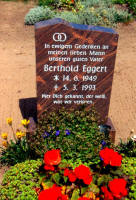|
 Genealogists
who plan research trips around visitation of cemeteries may find
this is a hard pill to swallow – but the fact of the matter is,
in Germany and in many other central European countries like
Belgium, Holland, Switzerland and Austria, space is too tight to
allow the constant expansion of cemeteries. With 83 million
people living above ground in Germany, for example; a country
the size of our state of Wisconsin, there isn't much room
leftover for new burial plots. Genealogists
who plan research trips around visitation of cemeteries may find
this is a hard pill to swallow – but the fact of the matter is,
in Germany and in many other central European countries like
Belgium, Holland, Switzerland and Austria, space is too tight to
allow the constant expansion of cemeteries. With 83 million
people living above ground in Germany, for example; a country
the size of our state of Wisconsin, there isn't much room
leftover for new burial plots.
The outlines and
dimensions of a cemetery are usually constant, kept the same as they
have been for hundreds of years. Sometimes the cemetery surrounds
the church. In this case, right across the wall from the cemetery
there could be homes, businesses and streets. There just isn't any
room for expansion. Even when the cemetery is located on the edge of
the town it's oftentimes competing with homes, apartment buildings
and industrial parks for space.
So what the Germans
and many of the other Europeans do, is after a period of about 15-20
years, if the family no longer pays for the upkeep and ``rental" of
the burial plot, the remains of the person buried there are removed,
the headstone is taken away, and a new person is buried in that
spot. The removal of remains is made a little easier by the fact
that unlike here in the USA, people are not buried in thick,
concrete vaults, along with a coffin. In Germany, after 15 or 20
years, the leftovers from a person's mortal life could probably fit
inside a shoebox.
In some towns, these
remains are placed into a common grave, which is marked but not
catalogued. So in other words, if a genealogist has fantasies about
going to Germany and finding dead relatives in the cemetery from the
1800s or even the early 1900s, those dreams need to be held in check
against the possibility that the grave may no longer exist.
 Headstones
are not always kept around. They may be used as foundations, steps,
pieces of roads, and discarded on a pile of rubbish. This is not a
reflection of the lack of sentimentality of the Germans, it's just a
fact of life as it continues. Headstones
are not always kept around. They may be used as foundations, steps,
pieces of roads, and discarded on a pile of rubbish. This is not a
reflection of the lack of sentimentality of the Germans, it's just a
fact of life as it continues.
Typically, when a
person passes on, the daughter or the son of the deceased will take
on the responsibility of caring for the plot. These graves are
maintained with extreme care and thoughtfulness, with fresh flowers
grown right on the grave, a weekly visit to make sure the flowers
and other plants are tended, and in some cases, a candle that is lit
on the grave for the celebration of the person's birthday. In all
cases, German cemeteries resemble parks or flower gardens more than
they resemble a final resting place. They are, to put it quite
simply, beautiful places to walk through.
When that son or
daughter gets to be in their middle or late 50s, the desire to
continue tending the grave of their parents dwindles, as they start
thinking about their own final resting place. This is the time when
usually, that grave is given up for someone else. That someone may
or may not be a family member.
In some cases, a grave
will have a stone that reads simply ``Familie Meyer." This grave
will often times contain the remains of generations of family
members, with only the living relatives knowing exactly who is
buried there.
 Official registration
offices are rare and can usually only be found at the very large
town cemeteries. In many cases, their records only cover those
people currently buried there, and therein lies the paradox. If
people only keep their graves for 15-20 years, then how do you know
if your ancestor was actually buried there at all, or what that
ancestor's wife's name was, or children? The genealogist's best
course of action is to get this information not from the dead, but
from the living, by brushing up on their German or by (with fingers
crossed!) finding someone in the town who can speak English and who
can answer questions about the families who have long since been
``recycled." Official registration
offices are rare and can usually only be found at the very large
town cemeteries. In many cases, their records only cover those
people currently buried there, and therein lies the paradox. If
people only keep their graves for 15-20 years, then how do you know
if your ancestor was actually buried there at all, or what that
ancestor's wife's name was, or children? The genealogist's best
course of action is to get this information not from the dead, but
from the living, by brushing up on their German or by (with fingers
crossed!) finding someone in the town who can speak English and who
can answer questions about the families who have long since been
``recycled."
What happens
to some headstones after the person buried beneath them is no
longer in the plot? Sometimes, but not always, those headstones
are leaned up against the walls of the church.
|